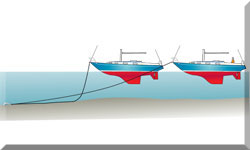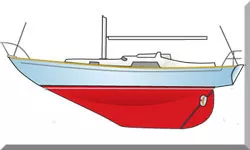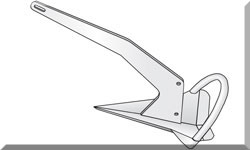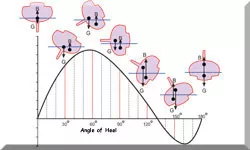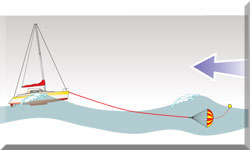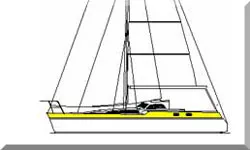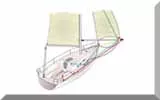- Home
- Cruising Yachts 30' to 35'
- Wauquiez Gladiateur
The Wauquiez Gladiateur 33 Sailboat
Specs & Key Performance Indicators
The Wauquiez Gladiateur 33, a masthead sloop, was designed by Donald Pye (of Holman & Pye) and built in France by Henri Wauquiez.
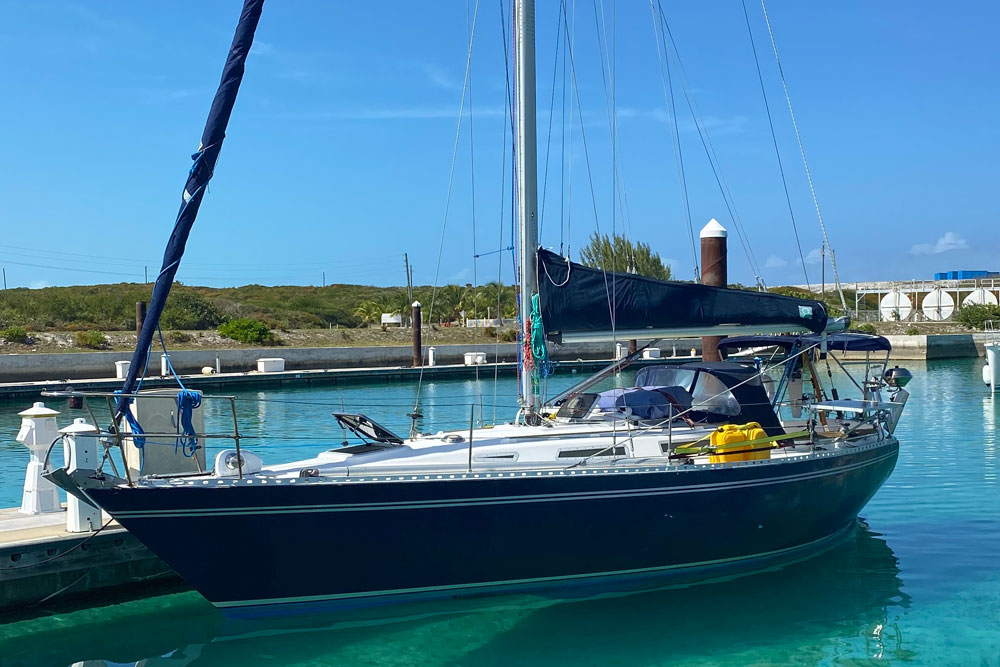 'Kesh', a Wauqiuez Gladiateur 33
'Kesh', a Wauqiuez Gladiateur 33Published Specification for the Wauquiez Gladiateur 33
Underwater Profile: Fin keel & Skeg-Hung Rudder;
Hull Material: GRP;
Length Overall: 32'10" / 10.0m;
Waterline Length: 27'3" / 8.3m;
Beam: 11'0" / 3.3m;
Draft: 6'0" / 1.8m;
Rig Type: Masthead sloop;
Displacement: 11,000lb / 4,990kg;
Sail Area/Displacement Ratio: 17;
Displacement/Length Ratio: 243;
Designer: Donald Pye (Holman & Pye);
Builder: Henri Wauquiez (France);
Year First Built: 1977;
Year Last Built: 1986;
Number Built: 299;
Published Design Ratios for the Wauquiez Gladiateur 33
- A Sail Area/Displacement Ratio of 16.8 suggests that, in the right conditions, the Wauquiez Gladiateur 33 will approach her maximum hull speed readily and satisfy the sailing performance expectations of most cruising sailors.
- A Ballast/Displacement Ratio of 43.7 means that the Wauquiez Gladiateur 33 will stand up well to her canvas in a blow, helping her to power through the waves.
- A Displacement/Length Ratio of 243, tells us the Wauquiez Gladiateur 33 is a moderate displacement cruiser, which means she'll carry all your cruising gear without it having a dramatic effect on her performance. Most of today's sailboats intended for offshore cruising fall into this displacement category.
- Ted Brewer's Comfort Ratio of 24.1 suggests that crew comfort of a Wauquiez Gladiateur 33 in a seaway is similar to what you would associate with the motion of a coastal cruiser with moderate stability, which is not encouraging news for anyone prone to seasickness.
- The Capsize Screening Formula (CSF) of 2.0 indicates that a Wauquiez Gladiateur 33 would not be the wisest choice of sailboat for ocean passage-making owing to the lower resistance to capsize in strong winds and heavy seas that is associated with similar sailboats that have a CSF of 2.0 and above.
Design Ratios: Notes of Caution...
- The Sail Area/Displacement Ratio (SA/D): This ratio provides an estimate of the sail power relative to the boat's weight, which can indicate potential speed in various wind conditions. But it doesn't account for the efficiency of the sail plan, the rigging, or the skill of the crew. Real-world performance can vary significantly based on these factors.
- The Ballast/Displacement Ratio (B/D): This ratio gives an idea of the boat's stability and stiffness, which is crucial for handling and safety. But it doesn't consider the distribution of the ballast or the hull shape, both of which can greatly affect stability. A high B/D ratio alone doesn't guarantee a stable boat if the ballast is poorly distributed.
- The Displacement/Length Ratio (D/L): This ratio helps predict the boat's speed potential and its behaviour in different sea conditions. But it doesn't account for the hull design or the boat's overall weight distribution. Two boats with the same D/L ratio can perform very differently if their hull shapes are different.
- The Comfort Ratio (CR): This ratio estimates the boat's motion comfort in a seaway, which is important for long passages. But it doesn't consider the boat's interior layout, which can also affect comfort. Additionally, personal tolerance to motion varies, so a boat that is comfortable for one person might not be for another.
- The Capsize Screening Formula (CSF): This formula assesses the likelihood of a boat capsizing in heavy seas, which is critical for offshore safety. But it doesn't take into account the boat's handling characteristics or the skill of the crew. A boat with a low CSF can still capsize if poorly handled in severe conditions.
General Limitations
- Static Nature: These ratios are static measurements and don't account for dynamic factors like wave action, wind gusts, or crew actions.
- Simplification: They simplify complex interactions into single numbers, which can be misleading. Real-world performance is influenced by a multitude of factors that these ratios can't fully capture.
- Context: The context in which the boat is used (e.g., coastal cruising vs. offshore racing) can greatly affect how these ratios should be interpreted.
In summary, while these ratios provide valuable insights into the theoretical performance characteristics of a sailboat, they should be used as part of a broader assessment that includes practical experience, sea trials, and expert advice.
This article was written with the assistance of Gemini, a large language model developed by Google. Gemini was used to gather information, summarize research findings, and provide suggestions for the content and structure of the article.
Recent Articles
-
Which Type of Boat Fridge Is The Most Efficient?
Apr 24, 25 05:06 AM
The top opening boat fridge is reputed to be more efficient than the front opening type, but that may not be the case - and here, amongst other boat refrigeration considerations, is why -
Multihull Autopilot Selection is Not Straightforward
Apr 19, 25 01:25 PM
Whether its for a catamaran or a trimaran, tiller or wheel steered, a multi hull autopilot must be endowed with specific performance characteristics... -
Wheel-Steering Autopilots: Your Questions Answered...
Apr 18, 25 03:45 PM
Whatever your question, you should find the answer here

